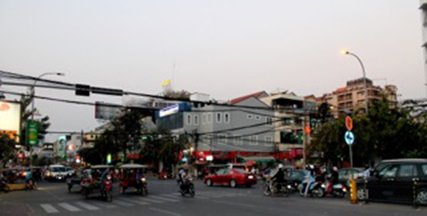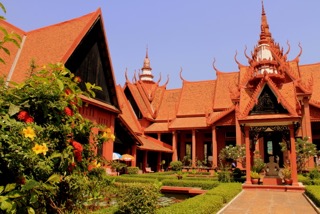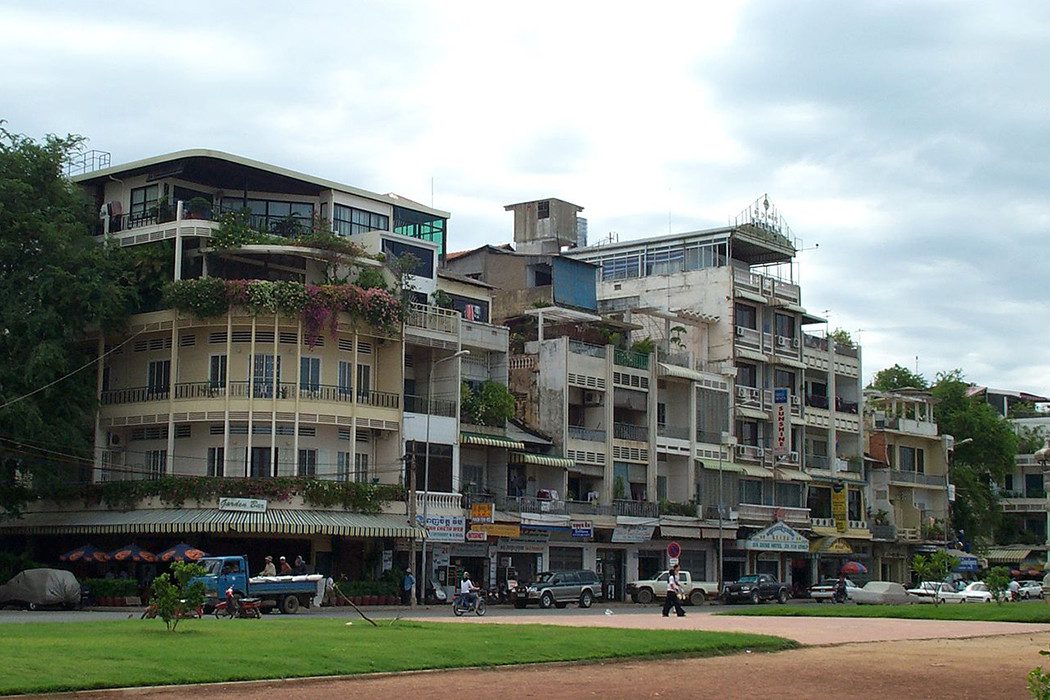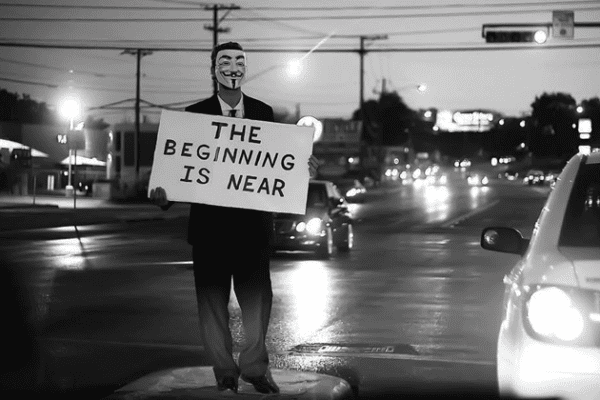Four decades after it fell to the Khmer Rouge, Udayan Dhar visits the Cambodian capital to understand the extent to which the wounds have healed.

A busy street in Phnom Penh
Our bus from Siem Reap reached Phnom Penh by dusk. The seven-hour bus ride, cutting across the Cambodian countryside of green paddy fields, marshy rivers, and hamlets of bamboo huts, brought us into the midst of a thriving metropolis that was as different from Siem Reap—a tourist base of guesthouses and hip restaurants—as night from day.
The streets were teeming with buses, tuk-tuks, and two-wheelers driven by stylishly dressed young men and women. One could get a sense of the cosmopolitan nature of the city from its many French bakeries, Chinese restaurants and dazzling Buddhist shrines.
It was already dark by the time we washed up. After having left our hotel in central Phnom Penh, we took a walk down the arterial city street, Sihanouk Boulevard, to the impressive Independence monument, a soaring commemoration of Cambodian freedom from the French in 1953. This monument is modeled on the central tower of Angkor Wat, the iconic temple that finds itself imprinted almost everywhere in this country—from the national flag to beer bottles. On our way back, we stopped at a hole-in-the wall café for some sumptuous, warm and sweet pork dumplings of a size we could never expect to find in India.
The relatively recent progress Phnom Penh has made fails to hide the deep wounds that were inflicted on it barely four decades ago.
But, the relatively recent progress Phnom Penh has made fails to hide the deep wounds that were inflicted on it barely four decades ago. As Vietnam and its neighbourhood became fair game for the Americans, Soviets and Chinese during the late 1960s and 70s, a vicious political struggle ensued within Cambodia. Not only did this lead to a civil war that displaced millions, but ultimately led to the fall of Phnom Penh in 1975, when the murky and brutal Khmer Rouge took over the country amidst much foreboding.
These sinister days were captured beautifully in the iconic Roland Joffé film The Killing Fields (1984), based on what was witnessed by both Sydney Schanberg, a New York Times journalist covering the civil war, and his local representative Dith Pran. The following four years saw millions of citizens of this ancient and rich civilisation being forced to conform to Pol Pot’s dream of an ideal Communist state.
For his despotic regime, this meant a total extermination of the urban population, which he felt had been corrupted by French and English education, and resettlement into vast rural farming camps where “re-education” was accompanied by harsh labour and almost certain death for even the slightest hint of being anti-State. Particular targets were those considered to be “intellectuals”, former government workers, and Buddhist monks. As farming replaced industry, all economic activity ceased to exist. Banks, hospitals and schools too were shut down or destroyed across the nation, as Phnom Penh—which was emptied out within hours of its fall—turned into a ghost town.
The Tuol Sleng Museum, better known as Prison 21, was a school that was converted into a secret prison. A walk down the corridors of erstwhile classrooms is a gory reminder of how people in this idyllic land of rivers, mountains and ancient temples became pawns in a sinister global power play.
Two of the most gruesome edifices that remind the world of what happened here make for somber visits on an otherwise pleasant day in the Cambodian capital. One of them, the Tuol Sleng Museum, better known as Prison 21, was a school that was converted into a secret prison. A walk down the corridors of erstwhile classrooms, which were converted into torture rooms and prison cells—many of them still bloodstained—is a gory reminder of how people in this idyllic land of rivers, mountains and ancient temples became pawns in a sinister global power play.
Khmer leaders kept meticulous records of the alleged crimes of the inmates, and prison documents on display tell the sad tales of the thousands who perished. It is estimated that Prison 21 saw up to a thousand people being killed every day. When Vietnamese troops liberated the city in 1979, only seven were found alive.

Tuol Sleng Genocide Museum
The extent of the Khmer Rouge’s brutalities are once again brought out in stark relief at the infamous “killing fields” of Choeung Ek, about 14 kilometres southwest of the city. A former orchard, this otherwise tranquil place contains the remains of nearly 9,000 people exhumed in 1980 from mass graves, many of whom were still bound and blindfolded. Fragments of human bone and bits of cloth are scattered around the exposed pits.
Walking around this place is mind-numbing as one is reminded of the unspeakable atrocities that occurred here not so long ago. Estimates vary, but 1.4 to 2.2 million people were killed by the Khmer Rouge. The true extent of the crimes became apparent to the wider world only over a period of time. Indeed, such were the ironies of Cold War politics that as late as 1982, the US and UK supported the Khmer Rouge’s inclusion at the United Nations as representatives of the Cambodian people.
After such a gruesome reminder of history, it was almost a relief to take a walk down the majestic Tonte Sap river, which merges with the mightier Mekong downstream. The Sisowath Quay along the river is lined with fine bars, cafes and bakeries. In addition to offering a beautiful view, Blue Pumpkin’s wholesome breads, cakes and ice-creams make it one of the most popular bakeries in town—both with locals and tourists.

Bai Sach Chrouk
The next day, we woke up early and went out of the hotel for some local Cambodian breakfast. Not to be missed, on almost every street corner in the city, one finds this incredibly delicious and filling breakfast—bai sach chrouk. It consists of thinly sliced pork that has been grilled over warm coals, served over a hearty portion of broken rice along with a helping of pickled cucumbers and daikon radish with ginger. On the side, one gets a bowl of chicken broth topped with scallions and fried onion. Some creamy Chinese coffee added to this gastronomic delight, and I swore I could have this for breakfast every day.
After breakfast, we went visiting the other major sights of the city, such as the National Museum. A graceful terracotta structure of traditional design, it housed some stunning pieces of Khmer art, from ancient statues of Vishnu and Shiva to a serene meditating Jayavarman, who is regarded by Cambodians and historians alike to be one of the greatest and most powerful of the Khmer monarchs. I spent a good deal of time strolling around the pretty courtyard garden embellished with Buddha statues and fish-filled pools of water. The museum was followed by the massive Royal Palace, with its classic Khmer roofs and ornate gilding, and Wat Phnom, a Buddhist shrine set on top of a 27-metre-high tree-covered knoll, the only “hill” in town—all a short tuk-tuk ride from each other.

The National Museum
Since that evening was my last one in the city, I thought it is a good time to explore its night life and gay culture. Cambodia is very tolerant of alternative sexuality, and Phnom Penh’s gay scene is intimate and easy to navigate- most gay pubs, bars and cruising areas are concentrated within the South-Central district.
I picked the very popular and amusingly named Love Spa for my evening. Located at the intersection of Streets 105 and 350, it isn’t difficult to miss except for the faded board that announces its existence. The two story building contains a spa, steam room and plunge pool on the ground floor, and private cabins and a café on the first floor which hosts cabaret shows on Tuesday and Saturday evenings.
Unlike Bangkok’s commercialised and overcrowded gay scene, the crowd here is almost entirely local—most visitors are young Khmer students and professionals—and an Indian man attracts attention. I do not speak Khmer, and so had to rely on my very limited knowledge of French to communicate with the other patrons.
Witnessing the open gay culture in the capital of a comparatively impoverished nation that is still recovering from the traumatic period it went through so recently, it is difficult to comprehend what holds back gay entrepreneurship in India.
The city boasts of a fairly good number of gay-owned businesses. One that is popular with tourists is the Blue Chilli Bar, not very far from the National Museum. It is a gay and lesbian bar run by a Khmer/Thai couple and they have their own drag show on weekends. Witnessing the open gay culture in the capital of a comparatively impoverished nation that is still recovering from the traumatic period it went through so recently, it is difficult to comprehend what holds back gay entrepreneurship in India. Why even a metropolis like Mumbai does not have a single dedicated gay pub or restaurant, and why people have to rely either on mobile apps or risky rendezvous on local trains to meet other gay men, I will not understand.
The next afternoon, as I waited at the airport devouring the Double Whopper at Burger King—which you sadly don’t get in beef-deprived Mumbai—and leafing through Luong Ung’s memoir of life under the Khmer Rouge, First They Killed My Father, I could only wonder at the grit and resilience of the Cambodian people.Cambodia is a beautiful, ancient nation that has seen so many upheavals in its millennia-old history that it seems only natural that even the scale and severity of the recent brutalities could not put them down. That however, is not to say that one can afford to forget all that has happened, or been allowed to happen. The Khmer Rouge Tribunal has managed to indict several of Pol Pot’s compatriots for war crimes and rights violations. However, many others have died natural deaths- including Pol Pot himself- while some others are still at large. This is a country still coming to grips with its violent past, and one wishes for happier, more prosperous days to come.














